When the temperatures drop and the cold winds blow, it’s easy enough for us to add an extra layer or two to our outfits to protect ourselves, but what about our plants? While the hardiness zone of a plant may indicate that it is hardy in our zone (4b if you’re in the Twin Cities), there are several factors to consider when it comes to protecting our plants going into winter.
Location, location, location.
The exact location of plantings can make a big impact on the conditions they experience during extreme weather. Our zone is 4b, but that doesn't take into account the microclimates that can exist in your yard. The southwest side of a brick house will absorb sunlight and reflect it onto nearby shrubs, evergreens especially, causing them to warm up and sap to start flowing. During those clear winter days, wind can be a huge issue, causing those warm evergreens to be desiccated by subzero temperatures. A burlap wrap to help diffuse direct sunlight and harsh winds can help prevent windburn damage to evergreen shrubs in sensitive areas.

Other locational considerations for winter protection are shrubs in the path of snowfall from roof eaves. Evergreens are again very susceptible to damage from snow falling off of roofs because their needles catch the snow. In general, evergreens don't need snow protection because they are naturally flexible and have a good deal of “spring” in their branches. But the volume of snow that can come off of roofs in the spring, especially wet, heavy snow, can spell trouble for shrubs.
Warm Feet

Another factor for winter protection is the risk of freezing root balls. New plantings can be heaved out of the ground by the yo-yo-ing temperatures at the onset of winter causing the root ball to freeze and thaw, slightly changing its size each time. Snow cover acts as natural insulation to the top layer of soil and helps prevent heaving from occurring, but snow cover is not a reliable blanket until December or January in our region, so a blanket of straw or hay is a good substitute to provide an insulating layer for sensitive plants. Additionally, a garden bed that is surrounded by hardscaping like boulders or pavers can stay above freezing all winter, but the subzero winds mentioned above can still cause windburn damage, in which case a blanket of straw can help protect tender plants.
Critter Protection
A common problem that we see in the spring is the signs of critter damage from rodents, rabbits, and deer munching on plants in the winter. The damage may act as a lopsided pruning job but sometimes it is enough to permanently damage or even kill the plant. Chicken wire or hardware cloth are great choices for protecting particularly tasty plants, provided that it is secured to stakes to prevent tipping over. Burlap wrapping can do double duty as wind and critter protection for evergreens like arborvitae by discouraging nibbling from deer.
How do you know?
There are two primary ways to know that a plant will need winter protection. In general, observation in the spring of any damage that a plant incurred over the winter is the most accurate way to determine a winter care plan. By observing each plant on a property, we can assess the microclimates that exist on that property far more accurately than by guessing and checking.
Additionally, the installation of new plants during the growing season will automatically indicate that a winter care plan needs to be assessed for those new plants. Some basal crown-forming plants like Coral Bells Heuchera and Japanese Forest Grass Hakonechloa need winter protection in their first few winters, as they are particularly susceptible to heaving. Other plants that are installed late in the season may need insulation to protect their rootballs while they adjust to life in the ground.

Sometimes Mother Nature can surprise us, or your local fauna can decide they would like to take a bite out of something they hadn't shown interest in before, but regardless, preparation for winter is always a good idea. Though there isn't a one-and-done approach to winter protection, these considerations can help prevent plant loss and damage during the coldest months. Winter brings many challenges for the garden from cold temperatures, wind, critters, and heavy snow cover. By taking some simple preventative steps in the winter, we can help reduce or eliminate the chance of winter damage to your garden!





